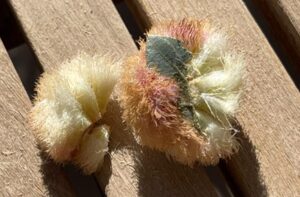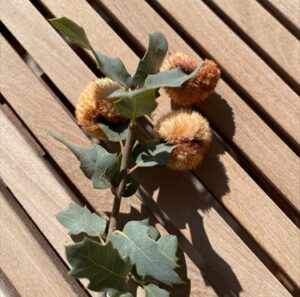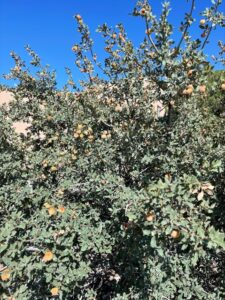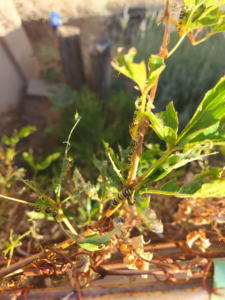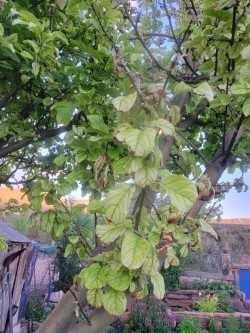HELPLINE PRACTICE QUESTIONS
LEAVE BLANK -DO NOT REMOVE - this must be here so the tabs are closed upon page load - Advanced CSS turns off display
1/14-1/20 - Climate
We have 2 new trembling aspens that have been doing well despite the initial transplant and our recent high winds.
Suddenly the outer edges of the leaves are darkened and dry on one tree and the other one has the outer edges of the leaves turning light brown and very dry. Both trees look like they will lose all leaves despite having a few spots of budding new growth.
Let me know if I should attach photos.
Thanks!
1/21 – 1/27 - Soil Properties and Building Healthy Soils
We are starting a home vegetable garden this year and believe we would benefit from getting a soil analysis completed. Our soil is mostly sand so we recently tilled compost purchased from our local farmer’s market.
We think the final soil ratio is 20% sand, 80% compost. The Village Mercantile told me that the compost is made up of ground bark and composted steer manure which has “cooled off” for at least 120 days. The Village Mercantile folks thought that the 20/80 mix that I have should be good for a vegetable garden and didn’t think any further supplements/fertilizer would be necessary.
So here are my questions:
1) Do you think I should add any other supplements or fertilizer to the soil?
2) Should I send 2 cups to Colorado and have a soil test performed for the $35 fee (per the Sandoval County Extension office form)?
Any other thoughts/comments would be welcomed. Thank you for your advice.
1/28 – 2/3 - Basic Botany: Plant Forms, Parts, & Functions How Trees Grow
2/4 – 2/10 - Plant ID
I have several New Mexico olives (Foresteria neomexicana). I am trying to understand which plants are male and which are female. They are currently in flower and what I am seeing is flowers with both pistils and stamens in the same flower, and on top of that there are multiple pistils in each flower. Dioecious plants are not supposed to do that. I have searched the Internet for a good botanical illustration of these flowers, but can’t find one. Do you possibly have a reference you can pass along?
2/18-2/24 - Integrated Pest Management Basics
Question 1.
I am a volunteer at the Family Practice Garden. One of our volunteers brought this specimen to me. The bugs are on his new lilac bush that was fine one night and the next day there was really nothing left except what is in the picture.
Initial SEMG Response (for clarification):
- Can you give me any help with the size of this bug? What kind of damage did it do to the plant?
- Do you see any signs or borer holes in the woody parts, or did they survive intact?
- Do you see anything unusual about the soil around the lilac?
- If damage was limited to the leaves, have they been eaten or sucked? If eaten, what shape and size are the bugs making?
- Where did you find the bug in the photo? Did you find lots of them?
- Are there other lilacs nearby, and are they also suffering?
Question 1 response (from person asking question):
Hi, Thanks for taking the time.
- The worm was attached to a branch of the lilac and to me it looked like a tomato worm with eggs attached?
- Approximately two inches long.
- All the leaves on a small lilac bush (14” tall and only one we have) were eaten overnight and no damage to the woody parts.
- The lilac is located in rock landscaped area with no visible sign of soil disturbance.
We do have tomato plants on the other side of the house where we find and remove horn worms occasionally, but no other plant affected so far.
Question 2. These larvae/caterpillars have decimated my Virginia Creeper. What are they? I assume they are not a beneficial insect once beyond the larval stage. Thanks for your help and advice.
2/11-2/17 Entomology
We have lots of these.
What are they? How should we treat them?
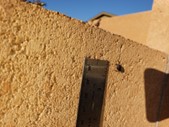
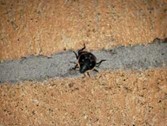
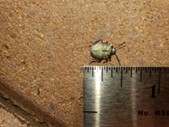
2/25 – 3/3 - Plant Pathology and Diagnostics
3/4-3/10 - Fruit Trees, Berries, Nuts
3/11-3/17 - Water cycle, watering the yard, and garden passive water saving techniques
Question 1. Hello! I’ve recently moved to New Mexico from Colorado where I had sprinklers for my lawn. Here we have a drip line system and I’m unsure about what I need to do to winterize it. With the sprinklers we used an air compressor to blow out all of the lines. What is recommended here?
3/18-3/24 - Tree Selection and Care
Question What could be causing my mature cottonwood tree to have started turning brown on one side all of a sudden?
This started about three weeks ago. It’s watered using drip irrigation on a timer set for 10 minutes twice a day, every morning and evening. Additionally, I’ve been using a sprinkler at least two times a week for 20 minutes at a time.
3/25 – 3/31 - Ornamentals
I am trying to grow milkweed to support Monarchs. I have planted 4 asclepias tuberosa. Two of them get full sun all day, and two get sun for 8 hours. The two who get shade in the afternoon are healthier. They are all on drip watering (3 times a week for 30 min.) Is it possible to overwater? What size emitter do you suggest? Don’t these usually do better with all day sun? When are Monarchs around?
4/1 – 4/14 - Vegetable Gardening, Pests
4/15 – 4/21 - Turf Selection and Care
My wife and I recently put down grass sod on Thursday, 31-August. We bought sod from Just Sprinklers in Rio Rancho. My wife was told this was a good time to put down sod. Do you agree?
The reason I am asking is – I’m attaching photos – that the lawn showed very brown dead looking patches the very next day. The store told me this is normal and just shock. Do you agree?
They told us to water 3x a day with sprinklers for 10-15 minutes over each section. After a week water 2x a day, and by the third week water 1x a day.
We did as instructed and put down four bags of soil mixed with one bag on peat moss.
If someone would like to text/call my cell phone I would be happy to provide more detail and take any advice you have. I greatly appreciate your time and experience with this matter.
My wife wanted grass and I’m the husband who doesn’t know anything about grass 🙂 Thanks for any help.
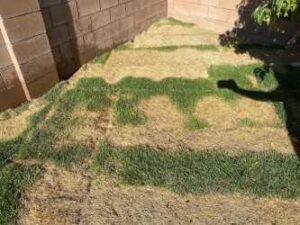
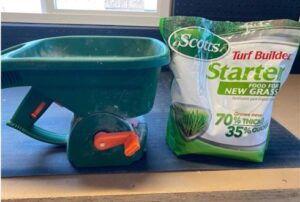
Sandoval Extension Master Gardeners Brochure
Need help? Here is our synopsis of best practices for High Desert Gardening in Central New Mexico

